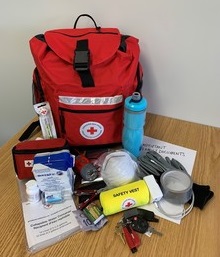Yet, statistics show that only one out of three Canadians will take all of the preparedness actions or any steps to be prepared in times of a disaster. This means many Canadians are not prepared in case of emergency. It could be for a myriad of reasons so we’re here to dispel a few common disaster myths.
1. It won’t happen to me.
If you live in Canada, it could indeed happen to you. Canada has approximately 8,000 wildfires and 24,000 house fires every year, as well as tornadoes and extreme storms through all parts of the country year-round, while flooding is the most common natural disaster that could affect you and your family in this country. A good first step to take is to know the risks in your community and how your municipality sends alerts or warnings.
2. The internet says it’s not that bad, or that it’s worse than it actually is.
 In those early days of an emergency, there can be a shortage of reliable information available while experts try to evaluate the situation, assess the risk to the public, and inform officials and the public about the best course of action to reduce the impact of the emergency. This is where misinformation and rumours start to circulate to fill that gap.
In those early days of an emergency, there can be a shortage of reliable information available while experts try to evaluate the situation, assess the risk to the public, and inform officials and the public about the best course of action to reduce the impact of the emergency. This is where misinformation and rumours start to circulate to fill that gap.There are very real dangers in relying on information that isn’t vetted or hasn’t come from a reliable source. Instead, seek out the latest updates from credible sources. In public health emergencies, we encourage people to follow the advice and updates from public health authorities, whether at the local level, or the Public Health Agency of Canada and the World Health Organization.
During disasters like floods or wildfires, look for your provincial governments, emergency officials and agencies, utilities and the Red Cross to share up-to-date information. This will often be shared through social media and online.
3. Things quickly return to normal anyway.
Just because the news stops covering the disaster does not mean it is not ongoing. Disaster recovery can take weeks, months, and even years, depending on the scale of the disaster. The Red Cross immediately responds to disaster but also plans for ongoing recovery in the coming weeks, months, years. It’s common to think that affected communities quickly return to normal, but the reality is, it is often rarely quickly. Watch one of our disaster response videos: How long does it take a community to recover?
4. Getting prepared is too expensive and too complicated.
 Purchasing all the items you need for you and your family to be ready for at least three days can seem expensive – but it is worth it. There are ways to prepare for disasters on a budget. Before purchasing anything, take stock of what you have at home, including first aid supplies and non-perishable food items. Chances are you have things you can put in your kit now and don’t need to buy. Find more tips on preparing for disasters on a budget.
Purchasing all the items you need for you and your family to be ready for at least three days can seem expensive – but it is worth it. There are ways to prepare for disasters on a budget. Before purchasing anything, take stock of what you have at home, including first aid supplies and non-perishable food items. Chances are you have things you can put in your kit now and don’t need to buy. Find more tips on preparing for disasters on a budget.5. You can’t plan for disasters, they happen too fast.
If you’re living in Canada, you can – and should - be prepared for disasters. Tornadoes, flooding, fires are very common in Canada. Know the risks in your own community, have your emergency kits ready for home and car, and make a plan so when the time comes, you can navigate your way to safety. By keeping an eye on local media, which will issue any weather alerts or warnings, you can be prepared.
Learn what to do before, during and after the emergencies and disasters that most commonly affect Canadians.
Related stories:

